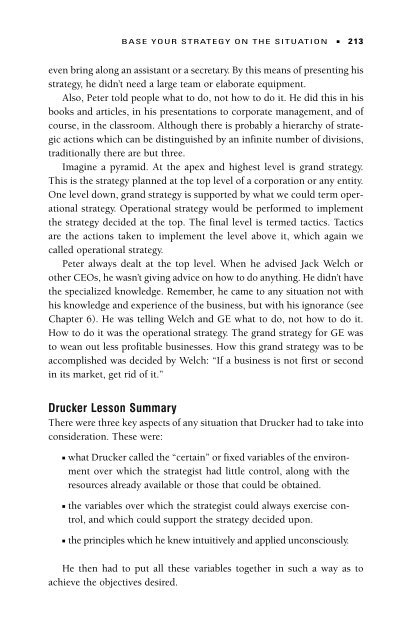A Class with Drucker - Headway | Work on yourself
A Class with Drucker - Headway | Work on yourself
A Class with Drucker - Headway | Work on yourself
Create successful ePaper yourself
Turn your PDF publications into a flip-book with our unique Google optimized e-Paper software.
BASE YOUR STRATEGY ON THE SITUATION ■ 213<br />
even bring al<strong>on</strong>g an assistant or a secretary. By this means of presenting his<br />
strategy, he didn’t need a large team or elaborate equipment.<br />
Also, Peter told people what to do, not how to do it. He did this in his<br />
books and articles, in his presentati<strong>on</strong>s to corporate management, and of<br />
course, in the classroom. Although there is probably a hierarchy of strategic<br />
acti<strong>on</strong>s which can be distinguished by an infinite number of divisi<strong>on</strong>s,<br />
traditi<strong>on</strong>ally there are but three.<br />
Imagine a pyramid. At the apex and highest level is grand strategy.<br />
This is the strategy planned at the top level of a corporati<strong>on</strong> or any entity.<br />
One level down, grand strategy is supported by what we could term operati<strong>on</strong>al<br />
strategy. Operati<strong>on</strong>al strategy would be performed to implement<br />
the strategy decided at the top. The final level is termed tactics. Tactics<br />
are the acti<strong>on</strong>s taken to implement the level above it, which again we<br />
called operati<strong>on</strong>al strategy.<br />
Peter always dealt at the top level. When he advised Jack Welch or<br />
other CEOs, he wasn’t giving advice <strong>on</strong> how to do anything. He didn’t have<br />
the specialized knowledge. Remember, he came to any situati<strong>on</strong> not <str<strong>on</strong>g>with</str<strong>on</strong>g><br />
his knowledge and experience of the business, but <str<strong>on</strong>g>with</str<strong>on</strong>g> his ignorance (see<br />
Chapter 6). He was telling Welch and GE what to do, not how to do it.<br />
How to do it was the operati<strong>on</strong>al strategy. The grand strategy for GE was<br />
to wean out less profitable businesses. How this grand strategy was to be<br />
accomplished was decided by Welch: “If a business is not first or sec<strong>on</strong>d<br />
in its market, get rid of it.”<br />
<str<strong>on</strong>g>Drucker</str<strong>on</strong>g> Less<strong>on</strong> Summary<br />
There were three key aspects of any situati<strong>on</strong> that <str<strong>on</strong>g>Drucker</str<strong>on</strong>g> had to take into<br />
c<strong>on</strong>siderati<strong>on</strong>. These were:<br />
■ what <str<strong>on</strong>g>Drucker</str<strong>on</strong>g> called the “certain” or fixed variables of the envir<strong>on</strong>ment<br />
over which the strategist had little c<strong>on</strong>trol, al<strong>on</strong>g <str<strong>on</strong>g>with</str<strong>on</strong>g> the<br />
resources already available or those that could be obtained.<br />
■ the variables over which the strategist could always exercise c<strong>on</strong>trol,<br />
and which could support the strategy decided up<strong>on</strong>.<br />
■ the principles which he knew intuitively and applied unc<strong>on</strong>sciously.<br />
He then had to put all these variables together in such a way as to<br />
achieve the objectives desired.


